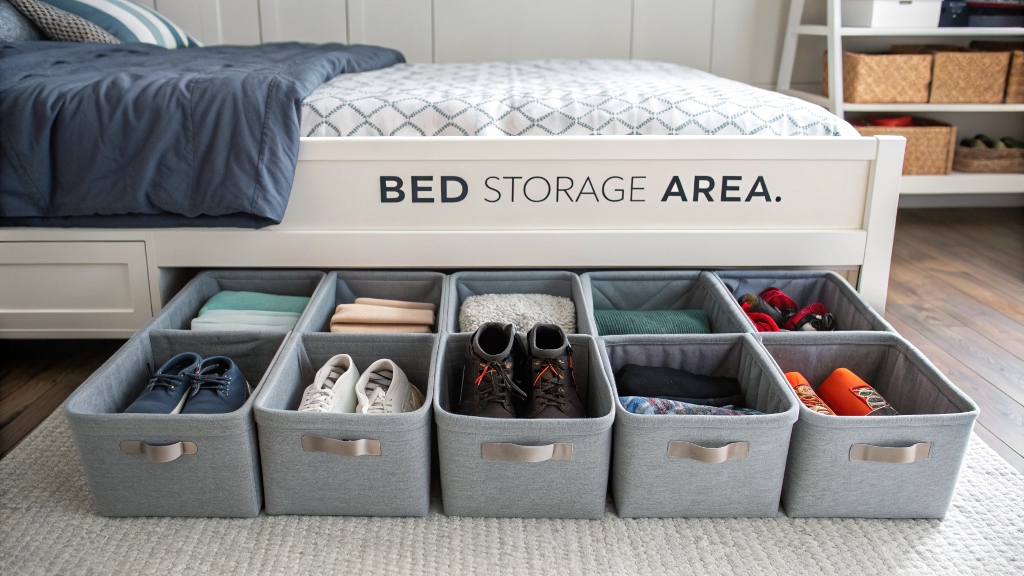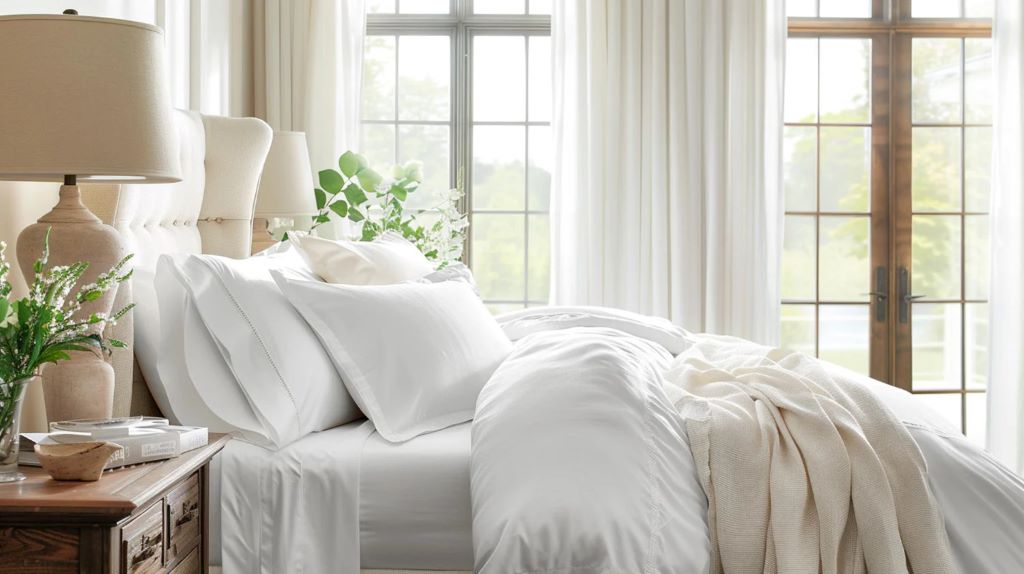Under-bed clutter is a common issue in households worldwide, turning a valuable storage space into a chaotic mess. The space beneath the bed, often overlooked, can be a goldmine for storage if organized effectively. This 3500-word article delves into the history of under-bed storage, current organizational strategies, key concepts, benefits, challenges, and future trends. Whether you’re a minimalist or a storage enthusiast, this guide offers actionable insights to transform your under-bed space into an efficient, clutter-free zone.
History of Under-Bed Storage
Early Uses of Under-Bed Space
The concept of using under-bed space for storage dates back centuries:
-
Ancient Civilizations: In ancient Egypt, beds were elevated, allowing baskets and pottery to be stored underneath.
-
Medieval Europe: Wealthy households used under-bed space for linens and clothing, often in wooden chests.
-
Colonial America: Trundle beds doubled as storage for quilts and household goods.
Evolution in the 20th Century
-
Industrial Revolution: Mass-produced furniture introduced standardized bed heights, making under-bed storage more accessible.
-
Mid-20th Century: Plastic storage bins and vacuum-sealed bags revolutionized how people stored items.
-
Late 20th Century: Modular furniture and built-in under-bed drawers became popular in urban homes.
Modern Context
Today, under-bed storage is a staple in small-space living, driven by urbanization and minimalist trends. Companies like IKEA and The Container Store offer specialized solutions, reflecting a growing demand for efficient storage.
Current State of Under-Bed Organization
Prevalence of Under-Bed Clutter
Under-bed spaces are often a default dumping ground for items like:
-
Seasonal clothing
-
Shoes
-
Books and magazines
-
Unused electronics
A 2022 survey by The National Association of Professional Organizers found that 68% of Americans use under-bed space for storage, but 45% report it as “disorganized” or “cluttered.”
Popular Storage Solutions
Modern solutions include:
-
Under-Bed Bins: Plastic or fabric bins with lids or zippers.
-
Rolling Drawers: Wooden or metal drawers on wheels for easy access.
-
Vacuum-Sealed Bags: Ideal for compressing bulky items like blankets.
-
Custom Built-Ins: Tailored drawers integrated into bed frames.
Technology Integration
Smart storage solutions are emerging, such as:
-
Inventory Apps: Apps like Sortly help track stored items.
-
Smart Bins: Bins with RFID tags for easy item location.
-
Adjustable Bed Frames: Beds with hydraulic lifts for easier access.
Key Concepts for Organizing Under-Bed Clutter
Decluttering First
Before organizing, declutter to ensure only essential items remain:
-
Sort Items:
-
Keep: Items used regularly or seasonally.
-
Donate: Gently used items no longer needed.
-
Discard: Broken or obsolete items.
-
-
The 80/20 Rule: Focus on the 20% of items used 80% of the time.
Categorization
Group items by type or use:
-
Clothing: Seasonal sweaters, jackets.
-
Bedding: Extra sheets, comforters.
-
Memorabilia: Photos, keepsakes in archival boxes.
-
Miscellaneous: Hobby supplies, gift-wrapping materials.
Accessibility
Prioritize ease of access:
-
Front Placement: Store frequently used items near the bed’s edge.
-
Labeling: Use clear labels or transparent bins.
-
Handles and Wheels: Opt for bins with handles or rolling drawers.
Space Optimization
Maximize the under-bed area:
-
Measure Dimensions: Ensure containers fit the bed’s height and width.
-
Stackable Bins: Use vertical space efficiently.
-
Dividers: Separate small items within bins.
Benefits of Organized Under-Bed Storage
Space Efficiency
-
Maximizes Small Spaces: Ideal for apartments or tiny homes.
-
Reduces Visual Clutter: Keeps items out of sight.
-
Increases Home Value: Organized homes appeal to buyers.
Time Savings
-
Quick Access: Well-organized items are easier to find.
-
Streamlined Cleaning: Fewer items to move during cleaning.
Mental Health Benefits
-
Reduced Stress: A tidy space promotes calm.
-
Sense of Control: Organization fosters a feeling of accomplishment.
Financial Savings
-
Avoid Duplicate Purchases: Know what you already own.
-
Repurpose Existing Items: Use old suitcases or boxes for storage.
Challenges of Under-Bed Organization
Physical Constraints
-
Low Bed Frames: Limit storage height (e.g., platform beds under 6 inches).
-
Heavy Items: Difficult to slide in and out.
-
Dust Accumulation: Under-bed areas are prone to dust buildup.
Organizational Pitfalls
-
Overstuffing: Packing too many items reduces accessibility.
-
Lack of Maintenance: Without regular upkeep, clutter returns.
-
Forgetting Contents: Unlabeled bins lead to forgotten items.
Environmental Factors
-
Moisture: Basements or humid climates can damage stored items.
-
Pests: Bedding and clothing attract moths or rodents.
Solutions to Challenges
-
Risers: Elevate low beds with bed risers.
-
Protective Covers: Use dust-proof, moisture-resistant bags.
-
Regular Audits: Review contents biannually to maintain order.
Step-by-Step Guide to Organizing Under-Bed Clutter
Step 1: Clear the Space
-
Pull out all items.
-
Vacuum or clean the area to remove dust.
Step 2: Declutter
-
Sort items into keep, donate, and discard piles.
-
Use a decision matrix:
Item Type
Keep If
Donate If
Discard If
Clothing
Worn in last 12 months
Good condition, not worn
Torn, stained
Bedding
Fits current beds
Clean, unused
Worn out
Memorabilia
High sentimental value
Shareable with family
Damaged, no value
Miscellaneous
Used regularly
Usable by others
Obsolete, broken
Step 3: Measure and Plan
-
Measure bed height, width, and depth.
-
Sketch a layout for bins or drawers.
Step 4: Choose Storage Solutions
-
Low-Profile Bins: For beds under 8 inches.
-
Rolling Drawers: For frequent access.
-
Vacuum Bags: For bulky items.
Step 5: Organize and Store
-
Categorize items.
-
Place frequently used items near the bed’s edge.
-
Label all containers.
Step 6: Maintain
-
Schedule biannual reviews.
-
Clean storage containers regularly.
Advanced Tips for Knowledgeable Readers
Custom Solutions
-
DIY Dividers: Create foam or cardboard dividers for bins.
-
Modular Systems: Invest in adjustable shelving units that fit under beds.
-
Archival Storage: Use acid-free boxes for heirlooms.
Sustainability
-
Eco-Friendly Materials: Choose bamboo or recycled plastic bins.
-
Upcycling: Repurpose old suitcases or crates.
-
Donation Networks: Connect with local charities for unwanted items.
Technology Integration
-
Smart Labels: Use QR codes linked to inventory lists.
-
Home Automation: Integrate with smart home systems for lighting under-bed areas.
-
3D Mapping: Use apps to create a digital map of stored items.
Seasonal Rotation
-
Winter Storage: Store summer clothes in vacuum bags.
-
Summer Storage: Swap for winter blankets.
-
Holiday Rotation: Dedicate bins for seasonal decorations.
Future Trends in Under-Bed Storage
Smart Storage Systems
-
IoT Integration: Bins with sensors to alert when items are misplaced.
-
Voice-Activated Access: Beds that lift via voice commands.
-
Augmented Reality: Apps to visualize storage layouts.
Sustainable Designs
-
Biodegradable Bins: Made from plant-based materials.
-
Modular Furniture: Beds with interchangeable storage components.
-
Circular Economy: Rental services for storage containers.
Minimalist Influence
-
Multi-Functional Beds: Beds with built-in storage and desks.
-
Transparent Storage: Clear bins for aesthetic appeal.
-
Decluttering Services: Professional organizers specializing in under-bed spaces.
Urbanization Impact
-
Micro-Apartment Solutions: Beds designed for 4-inch storage gaps.
-
Shared Economy: Community storage swaps for seasonal items.
-
Vertical Storage: Stackable units for high-rise living.
Review
This article provides a thorough exploration of under-bed organization, blending historical context with modern strategies. The step-by-step guide is practical, while advanced tips cater to seasoned organizers. The inclusion of a decision matrix and future trends adds depth, making it a valuable resource. However, some readers may want more visual examples or brand-specific product recommendations, which could enhance applicability.
FAQs
-
What is the best under-bed storage for low beds?
Low-profile plastic bins or vacuum-sealed bags are ideal for beds under 6 inches. -
How often should I reorganize under-bed storage?
Biannually, ideally during seasonal transitions, to maintain order. -
Can under-bed storage attract pests?
Yes, especially in humid areas. Use sealed containers and cedar blocks to deter pests. -
Are bed risers safe for heavy beds?
Yes, if rated for the bed’s weight. Check product specifications before use. -
What’s the most eco-friendly under-bed storage option?
Bamboo bins or repurposed suitcases reduce environmental impact.
Read More Also: How to Organize Under-Bed Clutter: A Comprehensive Guide
Conclusion
Organizing under-bed clutter transforms a neglected space into a functional asset. By decluttering, categorizing, and using smart storage solutions, you can maximize space, save time, and reduce stress. Despite challenges like dust or low bed frames, strategic planning and maintenance ensure long-term success. As urbanization and sustainability shape future trends, under-bed storage will evolve with smart, eco-friendly solutions. Start today with a clear plan, and your under-bed space will become a model of efficiency and order.






